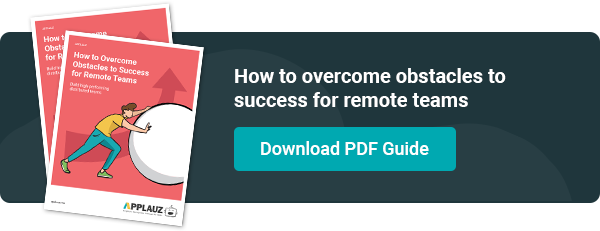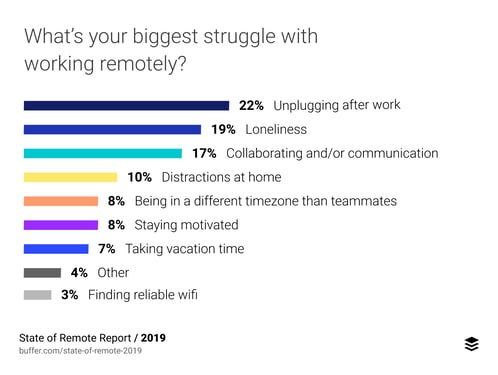A crying baby. A noisy upstairs neighbour. Loud roommates. Total isolation. Working at home presents a unique set of challenges for each employee.
But working at home also boasts notable benefits to employees: no commuting, for some individuals—fewer distractions, and a flexible schedule.
That said, for managers, leading teams that are not in the same place poses some serious challenges.
Questions of trust, productivity, motivation, communication, are on the minds of all supervisors.
 Setting new guidelines and expectations
Setting new guidelines and expectations
At the office, we behave in line with unwritten rules and expectations that we learn from experience, trial, and error.
For instance—you know never to go by Bob’s desk during a particular hour because he is always busy with a specific task.
Now that you are managing remote teams, there will be more trial and error to develop the same internal standards and expectations.
You can speed up the process by establishing a clear framework your team can work within. Proper guidelines serve to support employees so they can achieve great things while working from home.
Here are some essential dos and don’ts of managing remote employees. In consequence, you can establish reliable work-from-home policies and best practices for your teams.
The result: your employees will feel committed and empowered to do their best, even if no one is watching.

.jpg) DO: Acknowledge your employee’s unique circumstances
DO: Acknowledge your employee’s unique circumstances
At the office, everyone experiences (more or less) the same environment.
For example, if Dave from accounting is talking loudly on the phone and distracting you, Dave's loud voice is likely disrupting everyone in his vicinity as well.
In contrast, when working from home, each worker's experience is unique.
For instance, some employees might be with their small children at home. Others may be completely single and live alone. And others might even be living in large groups, with part of their close or extended family.
You can't control what goes on in your employee's home office. Still, you can, at the very least, be aware and validate their unique situation. Acknowledging each employee's position is key to building mutual respect and rapport.
Don't: discount the impact of your employees' particular work environment.
For instance, if you assume everyone has a calm and quiet place to work, you will be setting unrealistic expectations and pressure on your workers. Exercising empathy and understanding is crucial to keep employees motivated. When you do, your employees will reciprocate and thank you by producing work that exceeds your expectations.
DO: Set communication expectations from the start
When we work from home, 100% of communication is virtual. Undoubtedly, this gives rise to difficulties. Efficient communication is known to be a top challenge for remote teams.
We also use several tools to communicate with our colleagues and employees: video chat, phone call, instant messaging, email, and more, adding yet another obstacle to effective communication.
Avoiding communication breakdowns is conditional on setting proper expectations. In other words, encouraging clear and effective communication means everyone is on the same page.
That means making sure your employees are aware of:
- How often you'd like to formally check in with them
- Which communication medium you prefer
- Frequency of more casual communications
- Your responses delay expectations for (email, chat, etc.)
Don't: assume employees know how often you'd like them to check in. Or how fast they should be replying to your communication.
These guidelines don't need to be set in stone. But your employees should have an idea of the frequency of formal check-ins at the very least, so they can plan accordingly.
 DO: Build a virtual environment for peer-to-peer connection
DO: Build a virtual environment for peer-to-peer connection
"What motivates you to excel and go the extra mile at your organization?"
This question was asked in a recent study on employee motivation. The findings were summarized in a Psychology Today article, What Motivates Employees to "Go the Extra Mile?"
Can you guess what the survey found as the number motivator? And no, it's not a paycheck!
Number one on the list: camaraderie, peer motivation.
Peer approval and recognition is a critical driver of top performance.
The power of social approval is obvious in all areas of life—like social media, for instance.
These platforms play on the universal tendency for people to seek social respect.
In a recent New York Times article, Farewell, Office. You Were the Last Boundary Between Work and Home; the author asserts, "over the coming months, I suspect that those of us who spent most of our careers in offices will grow to miss them."
The author speculates the number one thing people will miss about office life: The camaraderie and the social bonds.
Don't: neglect the benefits of social culture and camaraderie in our professional lives.
We spend a great deal of our time at work; our colleague's validation and presence play a significant role in our motivation to do a good job.
Promoting a connected and friendly work environment is the biggest challenge for organizations implementing work from home arrangements.
Some ideas to help build virtual social environments:
- Using peer-to-peer recognition tools and social-driven apps to keep employees connected about work-related accomplishments.
- If the weather permits and your team is small enough, host an outdoor get-together or social activity a few times a year.
DO: Continue to recognize and reward employees
Employee rewards and recognition are key drivers of employee engagement.
These positive interactions foster trust and appreciation between colleagues. It's the foundation of building a vibrant company culture.
Not to mention, it's a universal truth: It feels good to be appreciated.
When you're in an office, it's easy to walk by an employee's desk to give a spontaneous "good job" or "thank you." It's also easy to celebrate or give a gift for an employee's work anniversary.
Offering recognition while your team works from home can be challenging. And sending an instant message to your employee doesn't hold the same weight as face-to-face interaction.
Don't: relegate recognition and appreciation to the bottom of your "to-do" list while employees work from home.
Continue to offer praise to employees when they do a good job. Also, ensure that you continue to celebrate work anniversaries and milestones.
Recognition is even more critical than ever in a remote work context. Appreciation inspires trust. And strong bonds characterized by trust and respect are needed more than ever.
That said, technology offers solutions to support your recognition efforts.
Pro Tip: Businesses can put in place an affordable third-party recognition tool like Appaluz. With a tool like this, colleagues working from home can offer each other official and public recognition on a social-media style app.
If you're not ready to put in place a formal recognition software, that's OK too. There are many options to keep recognition alive while working remotely. Start a recognition or anniversary channel in your favourite chat app. You can send out a weekly or monthly recognition email to your team and give a shout-out to the top performers that week, or those who are celebrating work anniversaries that month.
 DO: Monitor employee productivity with a results-oriented approach
DO: Monitor employee productivity with a results-oriented approach
To monitor your remote employees with software, or not to monitor?
It's a tough question many managers are asking themselves. Let's go to the source to explore these issues...
First off, recent reports confirm workers are encountering issues and tension with their manager's approach to monitoring productivity.
As a case in point, an anonymous employee expressed in this recent Vox report, "My manager knows every single damn thing I do...I barely get to stand up and stretch... I feel like I have to constantly be in front of the computer."
This leads us to an even thornier question: Where is the line between monitoring employees and total invasion of privacy?
Ask yourself this: Are you always watching your employee's screens at the office? Probably not.
Don't: track your employee's activity or screens without letting them know about it first.
This deceitful approach to monitoring is damaging to the employee-manager relationship. It has been shown to impact employee trust and morale.
The more reliable alternative: track productivity with precise results and goals. Some key ideas to track productivity:
- Promote accountability with an end-of-day report
- Use a shared calendar or project management app
- Establish and track daily quotas
- Set tasks with firm deadlines
That said, if the nature of your employee's work demands some level of surveillance, follow the expert's advice, and ensure full transparency.
Mac Quartarone, an organizational psychologist, explains for Vox, that employers should give as much autonomy as possible to employees. If they chose to monitor, employers should be 100% transparent about what they are virtually monitoring, and why.
DO: Continue to promote strong work/life balance and boundaries
Work/life balance is a fundamental driver of employee engagement.
A Flexjobs survey showed 82% of employees say they would be more loyal to their employers if they had flexible work options.
At first, working from home seems like the perfect solution, offering flexibility and a work/life balance for employees.
Recent research and insights from the largest "work from home experiment," have stepped in to challenge this assumption.
In short, working from home is a major catch-22. The arrangement seemingly allows flexibility in scheduling, but the flexibility is a liability, pressuring employees to remain "plugged in."
According to Buffer's State of Remote Work Report, the top challenge for employees working from home is "unplugging after work."

A Bloomberg report supports these claims by recently stating, "America's always-on work culture has reached new heights."
The report showcases an employee survey and found that a month into the pandemic, "about 45% of workers said they were burned out" after working from home!
Don't: expect employees to be continuously connected.
Promote and encourage work/life balance even while teams work from home. This means setting healthy boundaries for communication and response times.
For example, don't expect employees to respond to messages and emails at 10 pm. For the employees that are constantly plugged in, don't punish them for it, but don't publicly praise them either. Celebrating employees who are always plugged in sets an unhealthy expectation and pressure for everyone else. People with families or those caring for sick loved ones simply can't meet the same standards. If they are otherwise doing a good job, they shouldn't feel bad about setting healthy work/life boundaries.
 Final Thoughts: Respect & trust are key to growing a digital workplace
Final Thoughts: Respect & trust are key to growing a digital workplace
Keeping employee motivation and engagement high while teams work from home is a challenge. Fundamental values and initiatives can help build strong and connected working relationships.
Work/life balance, transparency, praise and recognition, are a few examples of the key drivers of engagement. This is true when employees are in the office. But also true when employees are working from home.
Please don’t assume that because employees are in their home office that managers can neglect these important work truths.
The remote work environment demands a strong foundation of trust and respect to thrive and grow. It’s never been more important to promote these core values in your workplace. New digital solutions, apps, and software can help make your virtual workplace become a reality.
About the author
 Michelle Cadieux
Michelle Cadieux
Michelle is a content writer for Applauz. She holds a Bachelor's degree in Psychology from Concordia University, and she has been writing about work and employee happiness for over five years.


